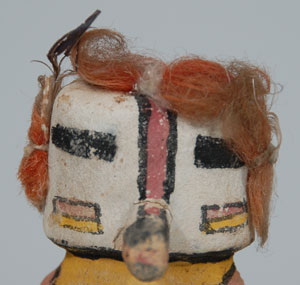Hopi Tawaquaptewa Katsina Doll [SOLD]
+ Add to my watchlist Forward to Friend
- Category: Traditional
- Origin: Hopi Pueblo, Hopituh Shi-nu-mu
- Medium: cottonwood root, paint, horsehair
- Size: 6-1/2” tall
- Item # 25544 SOLD

Wilson Tawaquaptewa was Kikmongwi (Chief) of Oraibi Village at the time of the famous rift that occurred on September 8, 1906, which divided the village into progressives and traditionalists. The progressives were in favor of cooperating with the U.S. Government's policy that Hopi children must go to school. The traditionalists wanted nothing to do with the government's policies.
Tawaquaptewa is the earliest carver that we know by name and he created figures that were given to the children as well as pieces that he sold. His carving career spanned at least four decades.
Tawaquaptewa would unhesitatingly alter the iconography of a Katsina doll in subtle ways. All his pieces were beautifully made and his style is quite identifiable although it is sometimes difficult to determine which katsina he had in mind while carving. This was not by accident. As a religious leader at Hopi, he was not comfortable with selling authentic katsina dolls to tourists, so he made slight changes to the carvings. This satisfied his conflict with religion and sales, and appeased the tourist who was unaware of the deception.
Condition: This doll is in very good condition. The paint is still mostly intact and the tones are soft, pleasing and harmonious. There is no damage to the carving except it appears that the snout has been re-glued at some time.
Provenance: from an Albuquerque gentleman
Reference: Kikmongwi as Artist: The Katsina Dolls of Wilson Tawaquaptewa by Barry Walsh. American Indian Art Magazine, Vol. 24, No. 1, Winter 1998.
- Category: Traditional
- Origin: Hopi Pueblo, Hopituh Shi-nu-mu
- Medium: cottonwood root, paint, horsehair
- Size: 6-1/2” tall
- Item # 25544 SOLD


